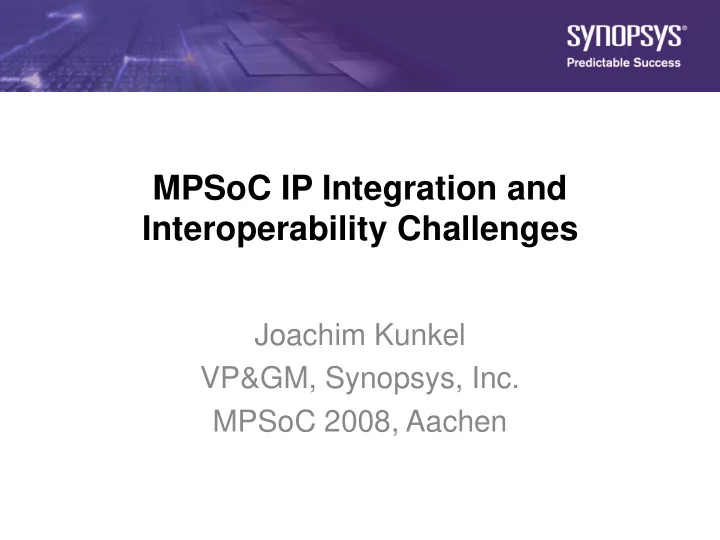

MPSoC IP Integration and Interoperability Challenges Joachim Kunkel VP&GM, Synopsys, Inc. MPSoC 2008, Aachen 1
Summary • MPSoCs are very application specific – Different architecture templates • Next generation of MPSoCs will also have lots of processors and lots of non processor IP as well • IP comes in many forms – Implementation – Verification – System-level • Integration challenges at higher levels of abstraction tough – Interoperability and standards – Connected with the implementation flows • SystemC TLM-2.0 is a great step forward – Will put increased focus on System-Level model availability 2
Where we seem to be going … SoC Networking Consumer Portable Consumer Stationary • Die area constant • Rapid progress • Performance > 120 TFlops • # cores increases by 1.4× / • Rapid increase in in 2022 • Functions in software year processing capability, • Core frequency up by 1.05× constraints on power • Data Processing Engines • Processing power / year • Worse performance – to- • On-demand accelerator increases by 1000× in the power ratio next ten years, engine frequency up by • Lifecycle long, application • Lifecycles short. 1.05× / year area wide Source: ITRS 2007 3
Lot’s of processors Consumer Portable Consumer Stationary Source: ITRS 2007 4
But Software is not everything … More IP Blocks, more Re-use • Yes, there are lots of processors • But there are other components too • Especially the protocols in a design require lots of connectivity IP • Mixed Signal content is also heavily growing • So – let’s not forget hardware IP Source: Semico 5
IP Comes in Many Forms Raising the Level(s) of Abstraction 6
System-Level Integration Challenges • System model interoperability? • How do users connect model abstractions – Transactor interoperability? • How do users verify the TLM model(s) itself – TLM Assertions – Verification IP for TLM – Verify against what? • How are models kept in sync – Against RTL – Against silicon revisions System-level model interoperability and an integrated flow are required 7
The Impact of SystemC TLM-2.0 Like Verilog in the 90’s! Bruegel, 1563 Tower of Babel Hardware Description Languages Virtual Platforms 1980’s 1990’s 1998 - 2008 Post 2008 Age of Proprietary HDLs HDL Standardization Proprietary APIs Age of Interoperability Verilog Verilog Roll your own (C, C++) TLM-2.0 VHDL VHDL SystemC TLM-1.0 HiLo HiLo Synopsys Virtio DABL DABL ARM AXYS APIs LASAR LASAR CoWare N2C APIs Aida Aida Virtutech APIs M (Lsim) M (Lsim) VaST APIs What it means for users: … QuickSim QuickSim UDL / I UDL / I 1. Model interoperability N dot, ISP, FBDL N dot, ISP, FPDL 2. System-level simulation commoditization 3. It’s all about the models! 8
The Impact of SystemC TLM-2.0 Enabling Interoperability and Scalability • Previously proprietary (backdoor) APIs & new additions have now been standardized: • (DMI) Direct Memory Interface – Direct backdoor access into memory – Allows un-inhibited ISS execution • LT (Loosely Timed) modeling – Declare but don’t execute timing – Allows speed/accuracy trade-offs • Temporal Decoupling – Only synchronize when necessary – Allows multicore speedup 9
Summary • MPSoCs are very application specific – Different architecture templates • Next generation of MPSoCs will also have lots of processors and lots of non processor IP as well • IP comes in many forms – Implementation – Verification – System-level • Integration challenges at higher levels of abstraction tough – Interoperability and standards – Connected with the implementation flows • SystemC TLM-2.0 is a great step forward – Will put increased focus on System-Level model availability 10
Recommend
More recommend